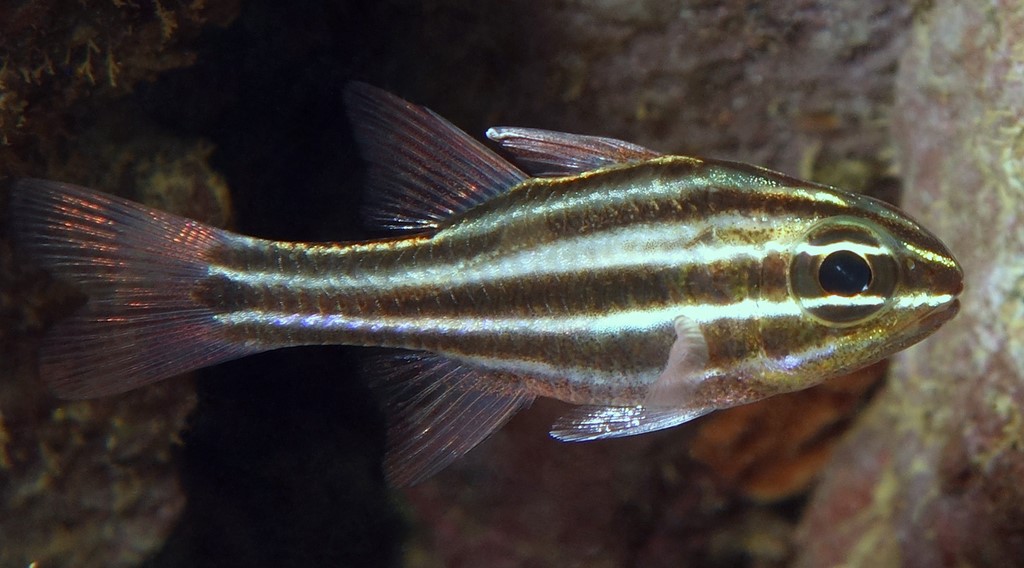OSTORHINCHUS COOKII - (MACLEAY, 1881)
Picture courtesy of: Yves Thévenet
Actinopterygii (Gigaclass) > Actinopteri (Class) > Teleostei (Subclass) > Gobiiformes (Order) > Apogonoidei (Suborder) > Apogonidae (Family) > Apogoninae (Subfamily) > Ostorhinchus (Genus)Poisson cardinal de Cook, Apogon de Cook, Cook's cardinalfish, Cook's soldierfish, Multilined cardinalfish, Blackbanded cardinal, Swartband-kardinaal, Suji-ishimochi, スジイシモチ, 다섯줄얼게비늘, 大目侧仔, 库氏天竺鲷,
Synonymes
Amia robusta (Smith & Radcliffe, 1911)
Apogon cookie (MacLeay, 1881)
Apogon cookii (MacLeay, 1881)
Apogon melanotaenia (Regan, 1905)
Apogon robusta (Smith & Radcliffe, 1911)
Apogon robustus (Smith & Radcliffe, 1911)
-----------------------------
Description
Dorsal spines (total): 8; Dorsal soft rays (total): 9; Anal spines: 2; Anal soft rays: 8; Pectoral fin rays: 14-15 (usually: 15); Lateral line scales: 24 + 3-4 (usually: 28); Median predorsal scales: 4; Total gill-rakers: 4-5 + 12-15; Developed rakers: 2 + 8-11; Ceratobranchial rakers: 8-9. Preopercle ridge smooth; Preopercle edge serrate. Body depth: 2.6-3.0 in SL and Head Length: 2.5-2.8 in SL; Snout length: 4.65-5.5, eye diameter: 2.7-3.2, interorbital width: 4.8-5.1 and upper-jaw length: 2.0-2.3 all in Head Length; Caudal-peduncle depth: 1.5-1.8 in its length, and peduncle length: 3.6-4.1 in SL. Caudal spot fairly large and distinct: 2.6-2.9 in caudal-peduncle depth. Max. length: 10.0 cm TL. Depth range: 1 - 10 m.
Color
In alcohol: body pale with 6 dark brown stripes wider than pale interspaces; Third stripe (postocular) relatively narrow, fading out below second dorsal fin; First dorsal and pelvic fins dusky to dark brown; Second dorsal and anal fins pale to dusky with dark brown basal stripe; Caudal fin pale to dusky; Peritoneum with scattered small dark spots; Intestine dark.
In life: interspaces between dark brown stripes bright white on head, changing to pale bluish on body; Lowest (6th) stripe reddish, continuing onto anal fin as a basal stripe with pale bluish upper and lower margins; Pelvic fins reddish with pale leading edge. The basal dark brown stripe of the second dorsal fin is much wider in adult males than in females and may occupy the entire lower third of this fin.
Etymology
Ostorhinchus: from Greek, osteon = bone + from Greek, rhynchos = beak. In reference to the bony jaws, very much advanced and jagged, which take the place of the teeth.
cookii: in honor of English artist and naturalist Edward William Cooke (1811–1880).
Original description: Apogon cookii MacLeay, 1881 - Type locality: Endeavour River and Erub (Darnley) Island, Queensland, Australia.
Distribution
Red Sea; Indo-West Pacific: East Africa, Persian Gulf, Socotra, Madagascar and Réunion (Mascarenes) east to Philippines, north to southern Sea of Japan, south to Queensland (Australia) and New Caledonia.
Biology
Inshore species of protected waters of lagoons and lee reefs; It is often found in tidepools and on shallow seagrass beds. Found close to ledges of rocky areas or coral reefs during the day. Nocturnal species. Solitary or in small groups. Mouthbrooders. Distinct pairing during courtship and spawning.
Similar species
- Ostorhinchus angustatus (Smith & Radcliffe, 1911) - Reported from New Caledonia - Link to the species (here) - Body white colored, with five poorly defined dark brown stripes on lateral surface of body, posterior end of third stripe reaching black spot on base of caudal fin; Base of caudal fin with spot subequal in size to pupil.
- Ostorhinchus nigrofasciatus (Lachner, 1953) - Reported from New Caledonia - Link to the species (here) - Differs in having 15-19 developed gill rakers (10 on ceratobranchial), usually 14 pectoral-fin rays, and no postocular stripe.
- Ostorhinchus taeniophorus (Regan, 1908) - Reported from New Caledonia - Link to the species (here) - Whitish with 5-6 black stripes. Secondary dark line extends backwards as far as the first dorsal fin, in large specimens. Absence of dark spot on caudal fin base.
- Ostorhinchus victoriae (Günther, 1859) - Reported from Eastern Indian Ocean: Rottnest Island (Western Australia) north to Northern Territory (Australia).
Last update: 4, October 2022
